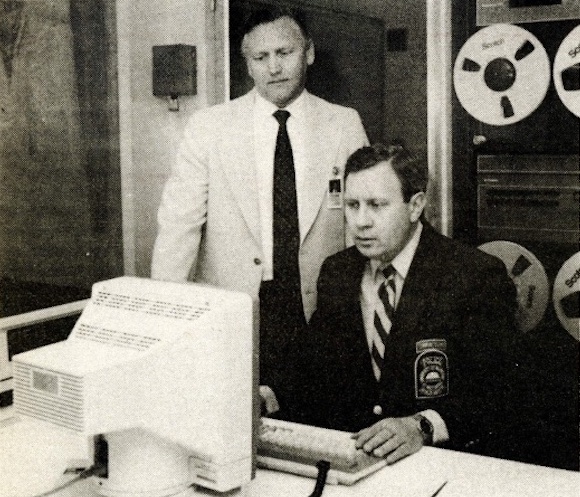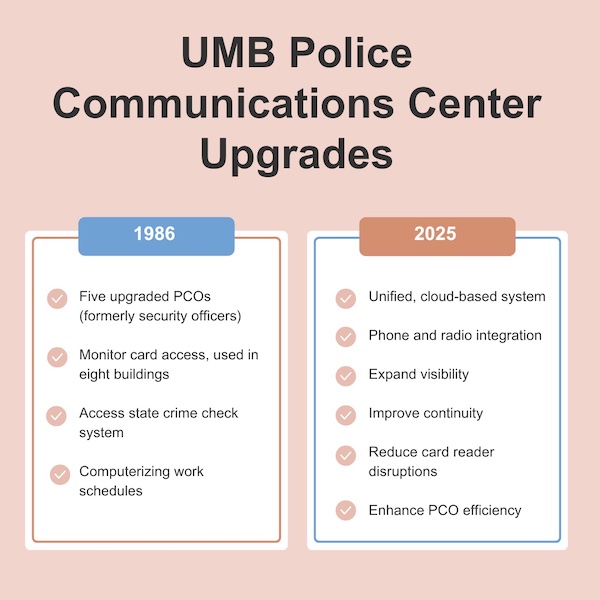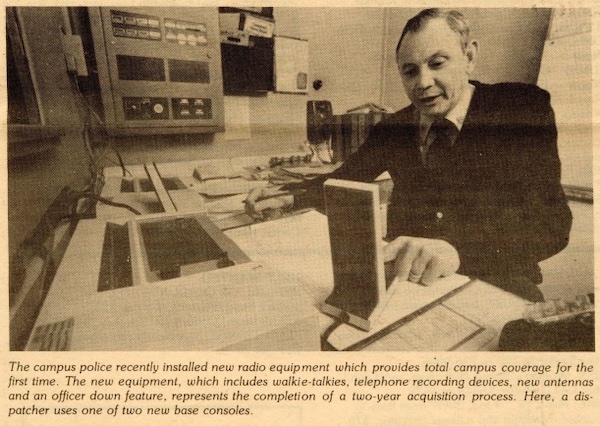Then and Now: The Evolution of UMB Police Dispatch
July 02, 2025 Carin Cardella
Thanks to new technology, strengthened partnerships, and a forward-thinking approach, UMB police communications is leading the way.
This story is one in a series celebrating UMB Police and Public Safety’s 50-year history, the milestones that shaped us, and the work we continue today.
“The communications center is the nerve center of the police force.”
These words from Col. Walter Pry come from a 1986 issue of The Voice — the University of Maryland, Baltimore (UMB) newspaper at the time — following upgrades to the department’s Police Communications Center (PCC). Today, UMB Police and Public Safety is again making significant upgrades.
“We’re becoming a next-gen center,” said Corey Johnson-Larkins, police communications supervisor. “UMB has one of the most advanced collegiate communications centers.”
Improving Visibility
Last year, the department was awarded a $750,000 grant from the Maryland Higher Education Commission to upgrade cameras on campus. Two hundred and seventy-five cameras have been replaced, with 50 to go.
“We’re replacing outdated, malfunctioning cameras first,” said Lt. Brett Etzler, who oversees the communications center. “These systems improve officer safety, real-time incident response, and can even prevent crimes.”
Before the upgrades, police communications operators (PCOs) managed several systems separately: phone calls, computer-aided dispatch (CAD), panic alarms, fire alarms, multiple camera networks, radios (including UMB police, security, maintenance, and parking, as well as local and state law enforcement partners), and more.
“The systems didn’t work together,” Johnson-Larkins said. “It was a lot of passwords to manage.”
These upgrades migrate multiple systems into a unified, cloud-based system.
Past Updates
In 1986, the department was proud to announce upgrades of its own. John Collins, director of public safety at the time, described “sleek new equipment” coming to the PCC.
The department hired five professionals with police communications experience. Previously, security officers staffed the operations center. For the first time, PCOs answered the phones for UMB public safety.
“Communication specialists are often the first contact an individual has with the police,” the 1986 article said. “They handle emergency, escort [Safe Walk/Safe Ride], and information calls, dispatch officers, and log calls.”
At the time, the PCC had a “bank of monitors both inside buildings and on campus.” The upgrades included a new computer to check state crime systems and a computerized system to manage employee schedules.
“It’s all part of the police department’s efforts to improve service and to bring the department into the computer era,” Collins said.
Into the Computer Era
Today, UMB PCOs can work pretty much anywhere — a huge improvement for continuity of operations during an emergency.
“Our old system worked on fiber-optic cables, and you had to work from a terminal,” Johnson-Larkins said. “If we moved to a backup location, someone would have to stay behind. Now, we can go wherever we want and just log in to the camera system.”
The web-based system also allows PCOs to search by clothing or vehicle description, making it easier to find footage and provide real-time monitoring during incidents.
“Our cameras are technically monitored 24/7, but they’re not being actively watched at all times by our dispatchers," Etzler said. “The camera feeds are always visible, but our staff have many other duties. They can’t catch everything in real-time.”
Johnson-Larkins agrees. “If there’s an area that no one goes in at night and someone breaks in, our cameras have a heat tracker that can show us there’s movement in that area. Now, we don’t have to go searching.”
In a stressful job, these small changes can make a big difference. After replacing outdated cameras, the department will add additional cameras in previous blind spots such as alleys. If a crime occurs, PCOs can more easily locate a suspect based on clothing or vehicle descriptions (e.g., yellow vest, red shoes, black truck), which can help officers prevent additional crime on campus.

Dispatching in the 21st Century
In 2000, Chief James Nestor established the CAD system for UMB police communications. According to a 2003 article in The Voice by Danielle Sweeney, the CAD system helps to “forecast crime trends and provide faster and better-informed campus police response.”
In 2021, UMB Police and Public Safety, the Office of Emergency Management, and the Center for Information Technology Services teamed with the Baltimore City 911 Center to establish an Aware Portal. The partnership allows UMB PCOs to see calls to Baltimore City 911 in real time for the UMB and University of Baltimore campuses. This means a faster response time to the correct location on campus.
The department didn’t stop there. A new consolette integrates phones and radios, which prioritizes incoming communications and streamlines PCO roles in an emergency. Calls and radio transmissions now come in through a headset, and the PCO can even use a foot pedal to activate their microphone.
“Our phones ring every 10 minutes,” Johnson-Larkins said. “Now we don’t have to pick up the receiver every time.”
Picking up a phone receiver may not seem like much, but in a true emergency, the PCOs can get flooded with calls. Streamlining all communications together can save precious seconds.
Keeping UMB Buildings Secure
PCOs in 1986 were monitoring card access for eight major campus buildings. Today, PCOs monitor more than 770 building card readers.
These, too, are being updated. The previous vendor had slow response times and high emergency service costs. The user management system relied on rubber-stamping building validations every 60 to 90 days, leading to issues and oversights within the system.
The department transitioned to a new vendor this year that provides 24/7 on-site response, reducing downtime and disruptions to card readers. At the same time, card readers got a software upgrade to improve security and integrate the access control panels into the panic and fire alarm system.

Into the Future
UMB police communications has come a long way in the department's 50-year history. Upgrades this year have improved efficiency, communications, and reliability. But the department isn’t done.
In a partnership with the Downtown Partnership of Baltimore (DPOB) and others, UMB is working toward a Strategic Operations Center (SOC) — a centralized hub for coordination, information-sharing, and data-driven strategies. The project was listed in Mayor Brandon Scott’s Downtown RISE initiative to provide public safety and community resources in downtown Baltimore.
DPOB’s State of Downtown 2024 Report describes the SOC as an opportunity to “enhance public safety, foster economic confidence, strengthen community well-being, and improve quality of life. Utilizing advanced technology and real-time data, this multi-agency initiative will bring together law enforcement, city agencies, business leaders, and community-based organizations to create a collaborative, proactive, and prevention-focused approach to public safety.”
Then to Now
From a single bank of monitors to a unified, cloud-based command system, the evolution of the UMB PCC reflects the department’s unwavering commitment to innovation, service, and safety. Today’s PCOs do more than answer calls — they work in high-stress situations, monitor multiple complex systems, and serve as the first line of response in keeping our community secure.
Thanks to new technology, strengthened partnerships, and a forward-thinking approach, UMB Police and Public Safety is not only keeping pace with the demands of modern policing, but also is setting the standard for what’s to come.